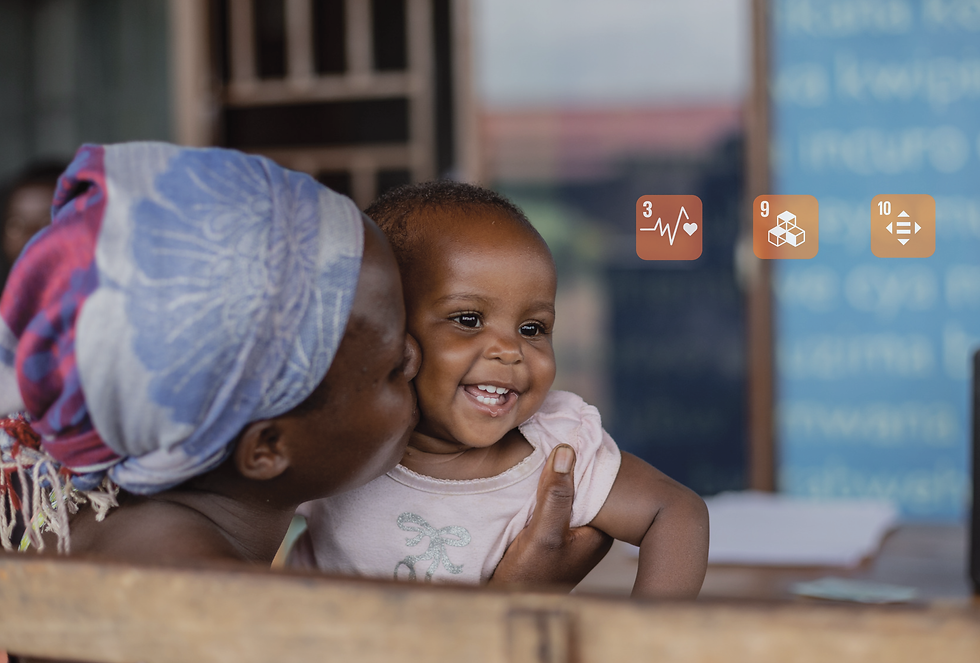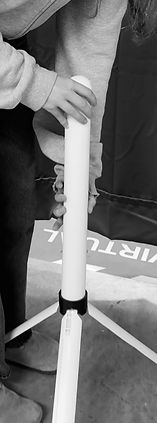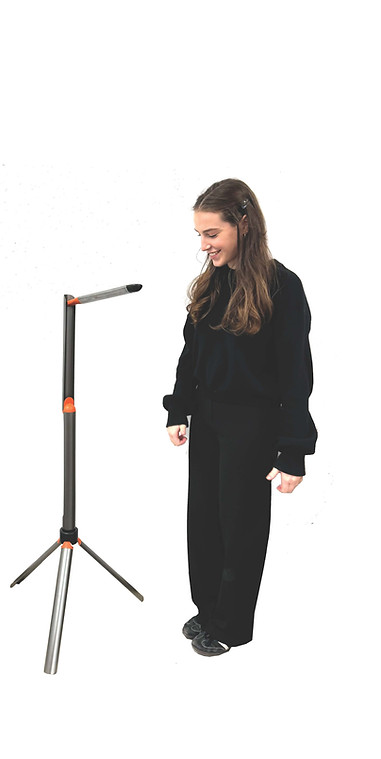


Halo
Portable medical light designed for mobile clinic programs in remote communities of developing countries.
Project Overview: The brief for this project was to innovate a medical light to suit a new context, while aligning with the principles of the United Nations' Sustainable Development Goals. In collaboration with other design students, we explored various potential applications for a portable medical light. We analyzed different environments, identified key users, and contexts. Through developing these scenarios, we gained a deeper understanding of the product, and uncovered opportunities for innovation. After brainstorming, the project became independent. I completed in-depth research, where my attention was drawn to healthcare systems in Africa, and the significant challenges they are facing. My objective became creating a portable medical light that could seamlessly integrate into existing healthcare initiatives, such as community healthcare programs and mobile clinics.
Studio Project: "Sustainable Development Project"
Duration: 7 Weeks
2024
Skills: Photoshop, Illustrator, Indesign, Photography, SolidWorks, Keyshot, Shop Work, 3D printing, Thermoforming



Product Autopsy
An existing medical light was broken down in order to analyze its design. The goal was to better understand the functional components of medical lights, assembly processes that were employed, and the technologies within. This hands on approach led to deeper insights into its ergonomic shortcomings, and lack of quality and durability. Through close examination areas for improvement and innovation were found.
Lighting Advancements

The medical lighting market has seen important advancements recently, offering various products to meet different healthcare needs. One of the most significant changes is the rise of LED (Light Emitting Diode) technology. LEDs are much more energy-efficient, lasting up to 25 times longer than traditional bulbs. According to the U.S. Department of Energy, LED lights use up to 80% less energy than incandescent and fluorescent lights, which not only cuts costs but also helps reduce the environmental impact of hospitals (Energy.gov). Additionally, LEDs
produce less heat, making them safer and more comfortable for patients and staff. Their ability to emit specific wavelengths of light can enhance visibility in places like examination and surgical rooms, improving the accuracy of diagnoses and treatments. Another crucial development in medical lighting is shadowless lighting, designed specifically for surgical environments. Traditional surgical lights can create shadows that block a surgeon’s view, making complicated procedures more difficult. As noted by XYC Medical, shadowless surgical lights use
advanced technology to provide even and consistent light, eliminating these shadows and improving visibility during operations (XYC Medical). This feature is vital for ensuring patient safety and precision during surgery. Shadowless lights often allow for adjustments in brightness, diameter, and color temperature, so they can be tailored to different types of procedures. Surgical lights also contain up to 6 joints allowing seamless movement through space for optimal positioning.
Current Market
There are several markets for medical lighting, each with a focus on particular healthcare requirements. The market for operating room lighting is dominated by surgical lights, which offer the intense, focused illumination needed for accuracy during intricate procedures. Exam lights are frequently utilized in clinics and doctor’s offices in the outpatient care industry to help healthcare professionals conduct comprehensive evaluations clearly. The market for emergency medical services (EMS) is significantly dependent on portable medical lights. These lights are essential for paramedics in the field because they enable them to examine and treat patients in poor light. Furthermore, the dentistry industry uses specialized lighting during procedures to improve vision inside the mouth cavity. Task-specific and portable lights are beneficial to the home healthcare sector as well since they enable caregivers to provide quality care in patients’ homes. Finally, portable and collapsible medical lights are crucial. Their lightweight design ensures for easy portability, enhancing patient care in challenging environments. In general, these varied marketplaces demonstrate how important medical lighting is to providing the best possible treatment for patients in a variety of healthcare settings.

PEN LIGHT
-Pupil reading for secondary EMS assessment
-Small
-Non-harsh light
-Lightweight
SURGICAL LIGHT
-Adaptable positioning
-Highest quality light in
the Industry
-Maximum light control
-5-6 joints
-Roof mounted
EXAMINATION LIGHT
-Portable (often on wheels)
-Second highest light quality in the Industry
-Similar technology to dentistry lighting
PARAMEDIC LIGHT
-High durability
-Clip-on
-270° adjustability
-Standard LED lighting
-Small
-Lightweight
COMBAT MEDIC LIGHT
Provides green, red and white light
Gear-compatible
Varying light intensity
Battery Powered
ILLUMINATED LOUPES
-Adjustable
-Ergonomic
-Applicable for surgeries
DERMATOSCOPE
-Hand-held
-High light quality
-Adjustable light aspects
HEADLAMP
Adjustable
Standard light quality
Diffuse light
Economical
Non-stationary

UN Goals
Throughout the scope of the project a primary focus was to adhere to the United Nations Goals of Sustainability. Goals 3, 9, and 10 were best addressed through the opportunity and development of a medical light. The targeted goals identified were; good health and well being, industry innovation and infrastructure, and reduced inequalities. Through addressing these goals, the designed product will be able to build stronger futures for the proposed users.
3. Good Health and Well Being
9. Industry, Innovation and Infrastructure
10. Reduce Inequalities
“Ensure healthy lives and promote well-being for all at all ages”
Proper lighting is integral to promoting good health and wellbeing. In the medical world, proper lighting reduces eye strain, improves working efficiency, affects people’s moods, and decreases the chances of errors for professionals. Improper lighting can disturb circadian rhythms, this combined with eye strain causes medical staff to experience burnout faster. Less efficient hospitals can help less people, and therefore decrease health and wellbeing. “In medical practice areas—consultation rooms, operating rooms, treatment rooms, research labs, and so on—high-quality lighting is a must, and it must be designed to support each practice […] offering the flexibility to properly illuminate different activities in the same spaces minimizes energy use” (E. Dayanova, 2024)
“Build resilient infrastructure, promote inclusive and sustainable industrialization and foster innovation”
At this time, half the world lacks access to vital health services. This is due to a lack of proper facilities, or insufficient systems. For example, many countries do not have access to free, or universal healthcare. Out of pocket payments are driving households into financial insecurity, with approximately 800 million people forced to spend 10 percent of their household incomes on medical expenses, and 100 million of these people facing expenses large enough to push them into extreme poverty (WHO, 2017). Designing proper infrastructure is far beyond the scope of this project however, it is hoped that through making medical lights accessible, existing systems can be improved to diffuse the challenge. Additionally, the medical lights will promote sustainable industrialization through consideration of the full product life cycle. Disposal, maintenance, material reduction, and material selection will be thoroughly researched to create thoughtful insights and influence sustainable design choices.
“Reduce inequality within and among countries”
Through brainstorming many shortcomings were identified of areas which do not have adequate medical lighting. These areas include, rural communities, low-income countries, zones of conflict, temporary health care facilities (emergency response clinics, natural disaster aid, etc.), and home healthcare situations. In an effort to improve health equity, focus will be narrowed into these markets, to create a medical light that is suitable and accessible to all who need it. Human’s access to healthcare should not be determined by where people are, “born, grow, live, work, play and age,” (WHO, 2024). Providing the best solution to these areas may not eliminate inequality, but it will act as one step in the right direction to reduce it.

Design Focus
Healthcare access in developing countries:
In 2021, approximately 4.5 billion people worldwide did not have access to essential health services (United Nations, 2023). Compounding this issue is the global shortage of healthcare workers, currently estimated at 7 million, with projections suggesting this could increase to 13 million by 2035. The shortage is driven by factors such as population growth, limited access to medical education, natural disasters which are worsening from climate change, and the growing number of health crises. The distribution of health workers is highly uneven, with developing countries facing significant gaps in healthcare staffing. For example, Sub-Saharan Africa, which accounts for 11% of the world’s population and 24% of the global disease burden, has only 3% of the world’s healthcare workers (PassMed, 2018). Moreover, brain drain, which is the emigration of skilled workers, has left large skill gaps (Witt, 2009). To bridge this gap, non-physician healthcare workers, such as mobile clinics or community health workers, extend access to essential services, by providing care to rural communities within developing countries (Sabet Sarvestani & Sienko, 2018). However, in order for these workers to provide the highest quality of care it is vital they are equipped with effective medical devices.
How do we design devices that can be used by Non-physician healthcare providers?
The World Health Organization estimates that 70% of medical equipment from developed countries fails to function in hospitals in developing countries (Vasan & Friend, 2020). The primary cause of this is because it is not contextually appropriate. To ensure the successful adoption of a product to this setting, it is essential to design with consideration for local socio-cultural, geographical, and environmental factors. Historically, equipment has failed in these areas due to power supply issues, user error, and a lack of resources for maintenance (Sabet Sarvestani et al., 2021). A strong consideration should fall on the production of the products. If items can be locally produced, not only will it increase its availability and lower costs, but it will increase the likelihood of product maintenance support. Medical devices designed for non-physician healthcare providers should be streamlined to only include essential features. This will ensure ease of use, minimal maintenance, reliance and dependability.



Design Statement
At this time, over fifty-percent of the world lack access to vital health services (WHO, 2017). For example in Sub-Saharan Africa, where 11 percent of the world’s population resides, there are only 3 percent of the world’s healthcare providers. Despite carrying 24 percent of the global burden of disease, they are constantly struggling with this insufficient amount of care (PassMed, 2018). Unfortunately, it is not uncommon for developing countries to be in a chronic need for increased healthcare providers and accessibility. Compounding this problem is that remote locations in these countries may be exceptionally far from hospitals and clinics, making them an infeasible option for those communities (Okiro & Ouma, 2018). To mitigate this, there are programs established to bring healthcare services to these communities. One of these programs is community healthcare workers (CHW) who are non-physicians (lay people) who are trained to provide preventive and primary care to their communities. Oftentimes, these areas also lack electricity. A medical light can be used to assist programs such as CHW’s, during their assessment visits. During these visits, lighting conditions can be unpredictable since they are relying entirely on natural light. Additionally, proper lighting will allow healthcare providers to work in shelter, giving them the ability to provide patients with privacy, restore dignity, and increase their trust. Lighting adjustability will be imperative in this environment; some medical assessments will require diffused/dispersed light and others will need focused lighting. In general, the environment that they are working in is less than optimal, with very limited space, and unsanitary conditions. Existing equipment that has been designed for hospitals in the Western World cannot be integrated in these communities, due to the limitations of electricity, and infrastructure.
Ideation
_edited.png)
.png)
Mechanisms and Assembly
Test Apparatus
Tripod Stand:
For the purpose of user testing, the tripod was stationary. The technology for the tripod movement will be adapted from existing products.
Arm Fitting:
The third arm must sit flush inside the second arm in order to clear the first arm during the initial rotation. The rounded end allows the user to have an easy surface to grab onto when opening this arm.
Arm Swivel:
Tapering along the three faces at the top allow for the arm to complete a full 180 degree turn. Axis of rotation created using nuts, and metal rods that are threaded on either end. Wedges on the inside create the flat surface that is needed to complete this movement.






User Testing
User testing revealed that the product could benefit from additional affordances to enhance its ease of use. One user noted that it was not immediately obvious that the swiveling hinge could rotate a full 360 degrees. However, they appreciated the level of customization offered by the multi-axis movement. Additionally, I observed that adjusting the arms requires two touch points, which prompted considerations regarding the materials used and the ease of cleaning.
Final Design


Battery Indicator
The battery indicator is visible when the light is opened. This way users can periodically check the battery levels throughout their day while using the light. It is indicated by 5 glowing green lights, when all the lights are on, the light is fully charged. When levels reach 2 light indicators they will softly flash in order to alert the user.



Textures
Located on the top of this arm there is a slightly darker tone of grey, and a more textured finish. This is to create an additional affordance, where users would grab to swivel the arm out from the base.

Light Diffusion Dial
The outset lightbulb icon on the dial acts as the arrow. When off, the dial points vertically down the light. ‘Off’ is indicated by no light, and ‘on’ is indicated by a green light. Automatically as the dial is turned the light shines on, and the diffusion of the light can be set to the address the user needs.

Colour Affordance
The colour orange acts as an affordance, as it is placed on all the moving parts. This is to increase the ease of use, as it creates a focal point to draw attention to these pivot points. Unlike traditional medical lights which are white, halo has darker and muter tones. In this context medical lighting is unfamiliar, so it is vital the light draws minimal attention from patients.
Manufacturing Considerations
Each metal element of this design will be manufactured as an aluminium extrusion, with some secondary cutting and anodizing operations. This will reduce the amount of parts needed, and minimize the cost. Aluminum has a high strength to weight ratio, and is corrosion resistant. This means it will be durable and lightweight for the user to carry from place to place. The extrusion profile incorporates slots where the injection molded (IM) parts will slide in and be fastened. This way the light can be easily and inexpensively assembled. Additionally, if individual components need to be replaced over-time, parts can be simply removed. This aligns with the original goals of the project as it has a contextually appropriate design, both inexpensive and easily maintained.


This series of sketches illustrates the straightforward operation of the light, from its closed position to its functional, in-use configuration.
Use Cycle
_edited_edited_edit.png)
Final Model
The body of the medical light (the parts intended to be manufactured by extrusion) were made out of two inch PVC tubing. Peices were cut to size using the bandsaw, and dremmel. The edges were sanded to obtain smooth surfaces, and radius were added where needed. The parts that are intended to be injection molded, were 3D printed and finished with drydex. Next, the LED housing was made using thermoforming. To get the translucent effect on the housing, the A-surface was covered with tape and the part was sandblasted. Parts that could be more easily made from foam were hand carved, sanded, and dry-dexed. Finishing details included airbrushing, and vinyl cutting.




